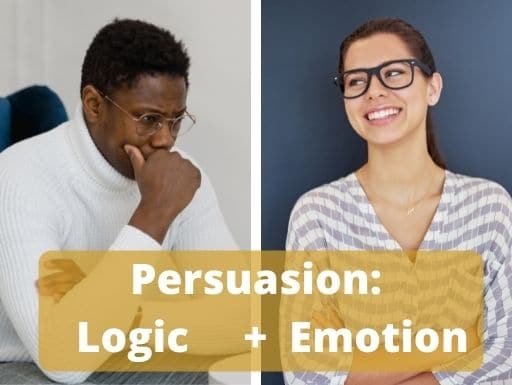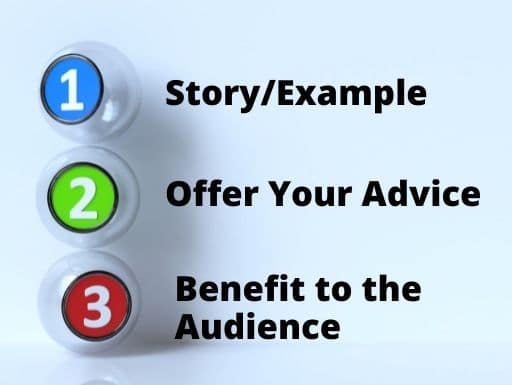
Most often, it actually causes the other person to want to play “Devil’s advocate” and argue with you. In this article, we are going to show you a simple way to win people to your way of thinking without raising resentment. If you use this technique, your audience will actually WANT to agree with you! The process starts with putting yourself in the shoes of your listener and looking at things from their point of view.
Background About How to Write a Persuasive Speech. Facts Aren’t Very Persuasive.

Most people think that a single fact is good, additional facts are better, and too many facts are just right. So, the more facts you can use to prove your point, the better chance you have of convincing the other person that you are right. The HUGE error in this logic, though, is that if you prove that you are right, you are also proving that the other person is wrong. People don’t like it when someone proves that they are wrong. So, we prove our point, the other person is likely to feel resentment. When resentment builds, it leads to anger. Once anger enters the equation, logic goes right out the window.
In addition, when people use a “fact” or “Statistic” to prove a point, the audience has a natural reaction to take a contrary side of the argument. For instance, if I started a statement with, “I can prove to you beyond a doubt that…” before I even finish the statement, there is a good chance that you are already trying to think of a single instance where the statement is NOT true. This is a natural response. As a result, the thing that we need to realize about being persuasive is that the best way to persuade another person is to make the person want to agree with us. We do this by showing the audience how they can get what they want if they do what we want.
You may also like How to Design and Deliver a Memorable Speech.
A Simple 3-Step Process to Create a Persuasive Presentation

The process below is a good way to do both.
Step One: Start Your Persuasive Speech with an Example or Story
When you write an effective persuasive speech, stories are vital. Stories and examples have a powerful way to capture an audience’s attention and set them at ease. They get the audience interested in the presentation. Stories also help your audience see the concepts you are trying to explain in a visual way and make an emotional connection. The more details that you put into your story, the more vivid the images being created in the minds of your audience members.
This concept isn’t mystical or anything. It is science. When we communicate effectively with another person, the purpose is to help the listener picture a concept in his/her mind that is similar to the concept in the speaker’s mind. The old adage is that a “picture is worth 1000 words.” Well, an example or a story is a series of moving pictures. So, a well-told story is worth thousands of words (facts).
By the way, there are a few additional benefits of telling a story. Stories help you reduce nervousness, make better eye contact, and make for a strong opening. For additional details, see Storytelling in Speeches.
I’ll give you an example.
Factual Argument: Seatbelts Save Lives

- 53% of all motor vehicle fatalities from last years were people who weren’t wearing seatbelts.
- People not wearing seatbelts are 30 times more likely to be ejected from the vehicle.
- In a single year, crash deaths and injuries cost us over $70 billion dollars.
These are actual statistics. However, when you read each bullet point, you are likely to be a little skeptical. For instance, when you see the 53% statistic, you might have had the same reaction that I did. You might be thinking something like, “Isn’t that right at half? Doesn’t that mean that the other half WERE wearing seatbelts?” When you see the “30 times more likely” statistic, you might be thinking, “That sounds a little exaggerated. What are the actual numbers?” Looking at the last statistic, we’d likely want to know exactly how the reporter came to that conclusion.
As you can see, if you are a believer that seatbelts save lives, you will likely take the numbers at face value. If you don’t like seatbelts, you will likely nitpick the finer points of each statistic. The facts will not likely persuade you.
Example Argument: Seatbelts Save Lives

When I came to, I tried to open my door. The accident sealed it shut. The windshield was gone. So I took my seatbelt off and scrambled out the hole. The driver of the truck was a bloody mess. His leg was pinned under the steering wheel.
The firefighters came a few minutes later, and it took them over 30 minutes to cut the metal from around his body to free him.
A Sheriff’s Deputy saw a cut on my face and asked if I had been in the accident. I pointed to my truck. His eyes became like saucers. “You were in that vehicle?”
I nodded. He rushed me to an ambulance. I had actually ruptured my colon, and I had to have surgery. I was down for a month or so, but I survived. In fact, I survived with very few long-term challenges from the accident.
The guy who hit me wasn’t so lucky. He wasn’t wearing a seatbelt. The initial impact of the accident was his head on the steering wheel and then the windshield. He had to have a number of facial surgeries. The only reason he remained in the truck was his pinned leg. For me, the accident was a temporary trauma. For him, it was a life-long tragedy.
The Emotional Difference is the Key
As you can see, there are major differences between the two techniques. The story gives lots of memorable details along with an emotion that captures the audience. If you read both examples, let me ask you a couple of questions. Without looking back up higher on the page, how long did it take the firefighters to cut the other driver from the car? How many CDs did I have? There is a good chance that these two pieces of data came to you really quickly. You likely remembered this data, even though, the data wasn’t exactly important to the story.
However, if I asked you how much money was lost last year as a result of traffic accidents, you might struggle to remember that statistic. The CDs and the firefighters were a part of a compelling story that made you pay attention. The money lost to accidents was just a statistic thrown at you to try to prove that a point was true.
The main benefit of using a story, though, is that when we give statistics (without a story to back them up,) the audience becomes argumentative. However, when we tell a story, the audience can’t argue with us. The audience can’t come to me after I told that story and say, “It didn’t take 30 minutes to cut the guy out of the car. He didn’t have to have a bunch of reconstructive surgeries. The Deputy didn’t say those things to you! The audience can’t argue with the details of the story, because they weren’t there.
Step 2: After the Story, Now, Give Your Advice
When most people write a persuasive presentation, they start with their opinion. Again, this makes the listener want to play Devil’s advocate. By starting with the example, we give the listener a simple way to agree with us. They can agree that the story that we told was true. So, now, finish the story with your point or your opinion. “So, in my opinion, if you wear a seatbelt, you’re more likely to avoid serious injury in a severe crash.”
By the way, this technique is not new. It has been around for thousands of years. Aesop was a Greek slave over 500 years before Christ. His stories were passed down verbally for hundreds of years before anyone ever wrote them down in a collection. Today, when you read an Aesop fable, you will get 30 seconds to two minutes of the story first. Then, at the conclusion, almost as a post-script, you will get the advice. Most often, this advice comes in the form of, “The moral of the story is…” You want to do the same in your persuasive presentations. Spend most of the time on the details of the story. Then, spend just a few seconds in the end with your morale.
Step 3: End with the Benefit to the Audience

So, the moral of the story is to wear your seatbelt. If you do that, you will avoid being cut out of your car and endless reconstructive surgeries.
Now, instead of leaving your audience wanting to argue with you, they are more likely to be thinking, “Man, I don’t want to be cut out of my car or have a bunch of facial surgeries.”
The process is very simple. However, it is also very powerful.
How to Write a Successful Persuasive Speech Using the “Breadcrumb” Approach
Once you understand the concept above, you can create very powerful persuasive speeches by linking a series of these persuasive stories together. I call this the breadcrumb strategy. Basically, you use each story as a way to move the audience closer to the ultimate conclusion that you want them to draw. Each story gains a little more agreement.
So, first, just give a simple story about an easy to agree with concept. You will gain agreement fairly easily and begin to also create an emotional appeal. Next, use an additional story to gain additional agreement. If you use this process three to five times, you are more likely to get the audience to agree with your final conclusion. If this is a formal presentation, just make your main points into the persuasive statements and use stories to reinforce the points.
Here are a few persuasive speech examples using this approach.
An Example of a Persuasive Public Speaking Using Breadcrumbs
Marijuana Legalization is Causing Huge Problems in Our Biggest Cities
Homelessness is Out of Control in First States to Legalize Marijuana
Last year, my family and I took a mini-vacation to Colorado Springs. I had spent a summer in Colorado when I was in college, so I wanted my family to experience the great time that I had had there as a youth. We were only there for four days, but we noticed something dramatic had happened. There were homeless people everywhere. Keep in mind, this wasn’t Denver, this was Colorado City. The picturesque landscape was clouded by ripped sleeping bags on street corners, and trash spread everywhere.
We were downtown, and my wife and daughter wanted to do some shopping. My son and I found a comic book store across the street to browse in. As we came out, we almost bumped into a dirty man in torn close. He smiled at us, walked a few feet away from the door, and lit up a joint. He sat on the corner smoking it. As my son and I walked the 1/4 mile back to the store where we left my wife and daughter, we stepped over and walked around over a dozen homeless people camped out right in the middle of the town. This was not the Colorado that I remembered. From what I’ve heard, it has gotten even worse in the last year.
So, if you don’t want to dramatically increase your homelessness population, don’t make marijuana legal in your state.
DUI Instances and Traffic Accidents Have Increased in Marijuana States
I was at the airport waiting for a flight last week, and the guy next to me offered me his newspaper. I haven’t read a newspaper in years, but he seemed so nice that I accepted. It was a copy of the USA Today, and it was open to an article about the rise in unintended consequences from legalizing marijuana. Safety officials and police in Colorado, Nevada, Washington, and Oregon, the first four state to legalize recreational marijuana, have reported a 6% increase in traffic accidents in the last few years.
Although the increase (6%) doesn’t seem very dramatic, it was notable because the rate of accidents had been decreasing in each of the states for decades prior to the law change. Assuming that only one of the two parties involved in these new accidents was under the influence, that means that people who aren’t smoking marijuana are being negatively affected by the legalization.
So, if you don’t want to increase your chances of being involved in a DUI incident, don’t legalize marijuana.
(Notice how I just used an article as my evidence, but to make it more memorable, I told the story about how I came across the article. It is also easier to deliver this type of data because you are just relating what you remember about the data, not trying to be an expert on the data itself.)
Marijuana is Still Largely Unregulated
Just before my dad went into hospice care, he was in a lot of pain. He would take a prescription painkiller before bed to sleep. One night, my mom called frantically. Dad was in a catatonic state and wasn’t responsive. I rushed over. The hospital found that Dad had an unusually high amount of painkillers in his bloodstream. His regular doctor had been on vacation, and the fill-in doctor had prescribed a much higher dosage of the painkiller by accident. His original prescription was 2.5 mg, and the new prescription was 10 mg.
Since dad was in a lot of pain most nights, he almost always took two tablets. He was also on dialysis, so his kidneys weren’t filtering out the excess narcotic each day. He had actually taken 20 MG (instead of 5 MG) on Friday night and another 20 mg on Saturday. Ordinarily, he would have had, at max, 15 mg of the narcotic in his system. Because of the mistake, though, he had 60 MGs.
My point is that the narcotics that my dad was prescribed were highly regulated medicines under a doctor’s care, and a mistake was still made that almost killed him. With marijuana, there is really no way of knowing how much narcotic is in each dosage. So, mistakes like this are much more likely.
So, in conclusion, legalizing marijuana can increase homelessness, increase the number of impaired drivers, and cause accidental overdoses.
If you use this breadcrumb approach, you are more likely to get at least some agreement. Even if the person disagrees with your conclusion, they are still likely to at least see your side. So, the person may say something like, I still disagree with you, but I totally see your point. That is still a step in the right direction.
For Real-World Practice in How to Design Persuasive Presentations Join Us for a Class
Our instructors are experts at helping presenters design persuasive speeches. We offer the Fearless Presentations ® classes in cities all over the world about every three to four months. In addition to helping you reduce nervousness, your instructor will also show you secrets to creating a great speech. For details about any of the classes, go to our Presentation Skills Class web page.
For additional details, see Persuasive Speech Outline Example.

